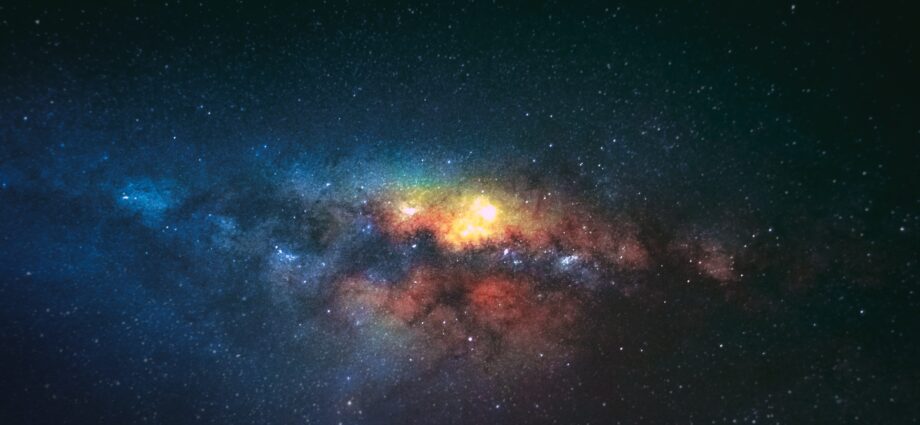
Evidence for ancient galaxies, discovered by NASA scientists, are challenging our most fundamental understandings of the Universe
by Stephen Hare
February 26, 2023
Using NASA’s James Webb Space Telescope, astronomers have discovered potentially “Universe Breaking” ancient galaxies, which, until now, widely accepted science said couldn’t exist.
Six galaxies estimated to have been present between 500-700 million years following the Big Bang event, 13.7 billion years ago, are sending shockwaves through the scientific community. Should further investigation confirm their existence, the basic rules of cosmology will need to be torn up and rewritten. But why?
James Webb Space Telescope: How does it work?
The use of telescopes as a tool to interrogate our fundamental understanding of the universe is nothing new. Telescopes work on the basic principle of collecting and magnifying the light from distant objects to make them visible.
Space telescopes, like the Hubble which famously launched in 1990, have played a key role in pushing scientific understanding across numerous areas of astrology and cosmology.
From the exploration of dark matter to determining the true age of the universe, Hubble has not only contributed to answering some of the biggest scientific questions of our time, but also revealed previously unimagined discoveries.

Seemingly, the newer James Webb Telescope is determined to continue this tradition. Its improved infrared light detection technology lends it 100x more power than Hubble, allowing novel and deeper examinations of space and the origins of the universe.
As the Universe continually expands, light traveling from objects in distant space towards earth is stretched in a process known as “red shift.” The redder the light detected, the further it has travelled, thus, redness is a proxy for age.
Utilising these technologies, scientists have been able to re-examine regions “seeing” up to 13.5 billion years ago, approximately 200 million years after the big bang. But, what have they found?
Consensus-shattering discovery
In July 2022, a patch of space adjacent to the “Big Dipper” constellation was re-examined using the Webb telescope.
![Sony PlayStation Store 110 - Sony, [Digital]](https://i0.wp.com/i5.walmartimages.com/asr/5d3e8d52-3525-4e75-b862-10394c67a31c.c3f21de9f6a2f65537248191772f43b3.png?w=1380&ssl=1)
According to Joel Leja, assistant professor of astrophysics at the University of Colorado and co-author of the Nature paper detailing the findings, high-resolution images obtained contained six blotches of extremely “unusually bright and red’’ dots.
Calculations suggest these objects are 13.3 billion years away. But, the age of the objects alone isn’t what makes them outstanding.
The measured intensity of the light detected is far larger than that emitted by a single point source, like a bright star or supernova, but is actually galactic in scale.
t was initially considered a mistake, as there are numerous ways telescopes can incorrectly perceive objects.
For example, gravitational lensing is a phenomenon first postulated by Einstein, detailing how light can be bent through gravitational fields as it travels through space, making it appear brighter than it is.
Through investigation, gravitational lensing has been dismissed (as have other ideas explaining away the phenomenon), leaving scientists to explore one glaring explanation. The data observed is evidence supporting the existence of mature galaxies much earlier than scientific consensus can explain.
Breaking the rules — how?
Current scientific consensus holds that galaxies only began to form about 350 million years of the Big Bang.
Known as dwarf galaxies, they are relatively tiny, forming through small clouds of stars, and contain up to 100 million stars. Mature galaxies like our own Milky Way, containing a minimum of 100 billion stars, were thought to take far longer to come into existence.
The newest galaxies observed by the Webb telescope are proposed to contain populations of 10-100s of billions of stars 500 million years after the Big Bang, a timeframe previously thought of as impossible.
Initial indiciations suggest that the largest of these galaxies is comprised of mass one trillion times greater than that of our Sun, or ten times that of the Milky Way.
Scientists working on the data have been extremely clear about their surprise. Erica Nelson, a professor in Astrophysics, said ‘’it’s bananas’,’ further clarifying that, ‘’you just don’t expect the early universe to be able to organize itself that quickly. These galaxies should not have had time to form.”
Despite the excitement amongst the scientific community, caution is being exercised in jumping to conclusions. That said, the implications for cosmological understanding are far-reaching.
Initial understandings — what do these findings mean?
Simply put, should findings prove to be correct, galaxy formation has been far more prolific than can currently be explained by the basic rules of cosmology.
Following the Big Bang event and a period of rapid and expansion, scientific models state the universe had to go through an extended period of cooling, over hundreds of millions of years, known as the “Dark age.”
Once conditions had cooled enough to allow gas to coalesce and collapse into the first star, it became possible for galaxies to form, but extremely slowly.
The proposed theory suggests the Milky Way gives birth to approximately two new stars per year. However, for the aptly named ‘‘Universe breaking’’ galaxies to exist within the newly proposed timeframe, they would have been forming hundreds of stars a year over hundreds of millions of years.
Potentially, the ‘Dark Age’ was not so dark after all, and the abundance of heavy elements such as Hydrogen and Helium, required for mature galaxy formation, was much higher than has been suggested.
Further investigation — next steps?
Of course, further investigations into the six “Universe breakers” are required.
Astrologers are confident that the Webb telescope’s near-infrared spectrograph (NIRSPEC), which surveys temperature, mass, and chemical composition of target objects, is more than capable of providing a conclusive answer regarding their existence.
Subscribe to our newsletter.
In the meantime, we can all impatiently wait to hear if the current cosmological rulebook is about to be torn up, and whether our fundamental understanding of the origin of the Universe itself is about to change.
This article was originally published on IMPAKTER. Read the original article.

